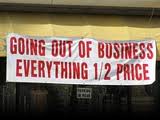How Much Inflation Is There Right Now?
 Wednesday, April 10, 2013 at 3:01AM
Wednesday, April 10, 2013 at 3:01AM There is a general suspicion that the inflation rate is greater than the 2% admitted by government statistics. My personal experience is that it is greater, as there seems to be month left at the end of our household money. How much is inflation? Honestly, I have no idea. The following chart will demonstrate this.
As you can see if the CPI, the consumer price index, was calculated the same way it was done in 1980 the inflation rate right now would be 10%. If the rate was calculated the same way it was in 1990, then the rate would be 5%. Obviously 10 and 5 is greater than 2.
But each of us has our own bundle of goods and services we buy each month. I started thinking about this as I read John Mauldin's weekly newsletter. He pointed out that inflation for him (he has children in college) was much higher than 2%. Similarly, someone with a lot of medical expenses is seeing a lot more inflation than 2%.
 Ours was a little smaller. But there are also areas where there is deflation. I remember how proud our high school was to have their own computer in 1971. My memory is hazy, but I think it was $35,000 and had 4K of memory. I also remember my second computer circa the mid 80's. I believe it had 512K and it had an internal hard drive of a whopping 10 Megs. I was really hot stuff back then. I paid about $3000 for it, used. Right now I am in the market for a computer and will spend $1300 for a computer with 8 Gigs of memory and 1 terabyte of storage. The computer industry is massively deflationary. This has to be factored in.
Ours was a little smaller. But there are also areas where there is deflation. I remember how proud our high school was to have their own computer in 1971. My memory is hazy, but I think it was $35,000 and had 4K of memory. I also remember my second computer circa the mid 80's. I believe it had 512K and it had an internal hard drive of a whopping 10 Megs. I was really hot stuff back then. I paid about $3000 for it, used. Right now I am in the market for a computer and will spend $1300 for a computer with 8 Gigs of memory and 1 terabyte of storage. The computer industry is massively deflationary. This has to be factored in.
 State of the Art—for the 80's. As wrong as the current 2% CPI is, are the others any better? As obvious as it is to me that the rate is more than 2%, it is just as obvious it is not 10%. This is another factor that is making investment so difficult. If one cannot model the future, all planning is virtually impossible.
State of the Art—for the 80's. As wrong as the current 2% CPI is, are the others any better? As obvious as it is to me that the rate is more than 2%, it is just as obvious it is not 10%. This is another factor that is making investment so difficult. If one cannot model the future, all planning is virtually impossible.
Obviously the future is not knowable—but right now it is not even guessable. But that won't stop me from guessing…prophecy is fun!
 I think the dollar is headed up, not because the US is in great shape, but because everyone else is worse—the cleanest dirty shirt, as one financial wag put it. What happens when the two trillion in excess bank reserves is spent? What happens when the dollars in foreign hands come home? I have no idea. But you can guarantee it will not be pretty. It could happen tomorrow. It could happen in ten years. Or I could be right, and the crisis is 3 to 7 years away.
I think the dollar is headed up, not because the US is in great shape, but because everyone else is worse—the cleanest dirty shirt, as one financial wag put it. What happens when the two trillion in excess bank reserves is spent? What happens when the dollars in foreign hands come home? I have no idea. But you can guarantee it will not be pretty. It could happen tomorrow. It could happen in ten years. Or I could be right, and the crisis is 3 to 7 years away.
Get ready.
 Economics
Economics 






